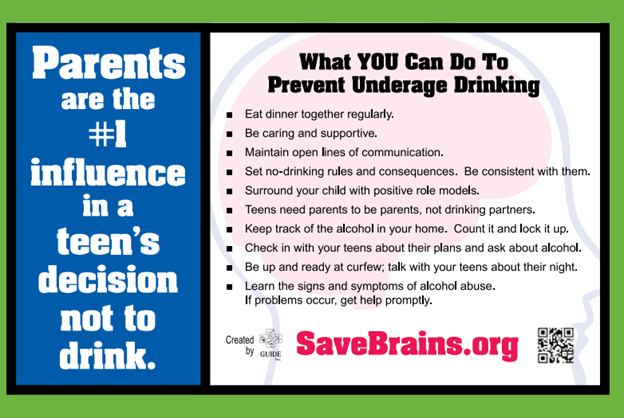While many factors influence one’s likelihood of developing a substance use problem, most agree that reducing risk factors—experiences, attributes, and environments that put certain individuals at higher risk—and improving protective and resiliency factors can influence outcomes. This calls for a holistic approach to prevention and intervention programming that seeks to enhance protective factors and diminish risk factors.

RISK FACTORS
A number of individual and environmental risk factors for developing a substance use problem have been identified.5 Individual risk factors include but are not limited to: genetic vulnerability, mental health issues (such as depression, anxiety, and attention deficit disorder), traumatic experiences, struggles with sexual identity, physical injury, chronic pain, stress, and individual perception of risk. One study found the number and severity of adverse childhood experiences has a direct relationship with the severity of alcohol use.19 Additionally, involvement in child welfare systems, such as foster care or the juvenile justice system, may be risk factors for substance use problems. Environmental factors may include parental substance use, peer group substance use, family conflict, and neighborhood factors.
People of any age, sex or economic status can become addicted to drugs/alcohol. Certain risk factors can affect the likelihood and speed of developing an addiction (List from the CDC, NIH, and other sources):
Drug addiction is more common in some families and likely involves genetic predisposition. If you have a blood relative, such as a parent or sibling, with alcohol or drug addiction, you’re at greater risk of developing a drug addiction. Favorable parental attitudes towards substance misuse also increases the likelihood of developing a substance misuse pattern.
If you have a mental health disorder such as depression, attention-deficit/hyperactivity disorder (ADHD) or post-traumatic stress disorder, you’re more likely to become addicted to drugs. Using drugs can become a way of coping with painful feelings, such as anxiety, depression and loneliness, and can make these problems even worse.
Childhood trauma like physical, emotional, or sexual abuse, physical or emotional neglect, death of a loved one, divorce, serious accidents/brain trauma, mental or physical illness, substance abuse in the home/family, violence against your mother, having a loved one in jail/prison, and long-term bullying or stressful life situations.
Peer pressure is a strong factor in starting to use and misuse drugs, particularly for young people. Association with peers who are delinquent or using substances can increase risk.
Students who do not feel connected to other adults at school or suffer from low academic achievement and/or learning issues struggle to feel acceptable and can turn to substance misuse as a source of connectivity.
Difficult family situations or lack of a bond with parents or siblings may increase the risk of addiction, as can a lack of parental supervision and involvement. Family rejection due to sexual orientation and/or gender identity may also increase the risk of developing addiction.
Using drugs at an early age can cause changes in the developing brain and increase the likelihood of progressing to drug addiction.
Some drugs, such as stimulants, cocaine or opioid painkillers, may result in faster development of addiction than other drugs. Both smoked and injected drugs enter the brain within seconds, producing a powerful rush of pleasure. The “high” fades and the person no longer feels good then the body requires more. Taking drugs considered less addicting — so-called “light drugs” — can start you on a pathway of drug use and addiction.
Having risk factors for substance abuse does not mean that it is inevitable. If you or someone you care about has one or more of these, you need to be especially aware of and watching for warning signs.
PROTECTIVE FACTORS
There are also individual and environmental protective factors that play a role in a youth forestalling initiation of substance use. Individual protective factors include but are not limited to knowledge of and attitudes towards risks associated with substance use, positive relationships with adults, peer groups that do not use substances, social competence, involvement and competence in positive activities/skills, positive future plans, a sense of well-being, and emotional regulation.
Environmental protective factors include but are not limited to close family relationships, clear expectations and limits regarding alcohol and other drug use, opportunity for community involvement and service, and available resources to meet social needs, including housing, health care, childcare, recreation, and jobs.
Social influence also plays an important role in adolescent substance use. The modeling of healthy attitudes and expectations around use of substances by parents, older siblings, and peers can delay the initiation of substance use. Conversely, substance use by these same people can act as a powerful negative social influence. Researchers have long recognized that problem behaviors are interrelated; experimental evidence shows that interventions which successfully change risk or protective factors are related to positive outcomes.
Some protective factors include:
- Parent or family engagement
- Family support
- Parental monitoring
- School Connectedness
- Parental disapproval of substance use
- Peer disapproval of substance use
- Positive relationships with adults
- Positive peer groups
- Involvement in positive activities
- Positive future plans
- A sense of well-being
- Ability to regulate emotions
- Clear expectations about use
- Opportunity for community involvement
- Knowledge of risks
HOW TO TALK TO YOUR CHILDREN
Take these steps to help your children and teenagers:
- Communicate. Talk to your children about the risks of drug use and misuse and that suicide is a permanent solution to a temporary problem.
- Listen. Be a good listener when your children talk about peer pressure, and be supportive of their efforts to resist it.
- Set a good example. Don’t misuse alcohol or addictive drugs yourself. Children of parents who misuse drugs are at greater risk of drug addiction.
- Strengthen the bond. Work on your relationship with your children. A strong, stable bond between you and your child will reduce your child’s risk factors.

